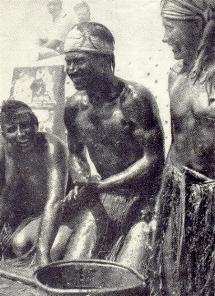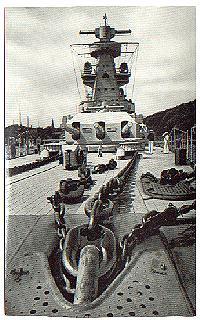

This pocket battleship first saw action in the Second World War when she
shot down a British aeroplane while lying in the Schillig Roads off
Wilhelmshaven. Her commander at the time was
Kpt.z.S.
Hans-Heinrich Wurmbach. In 1940 she was withdrawn from active service for a
general refit: the solid, rather typical pocket battleship control-tower and
bridge were replaced by a lighter type of mast, and she was also given a
clipper bow.
 Commerce Raiding
Commerce Raiding
After trials, she eventually broke out into the Atlantic
during October 1940 under command of Theodor
Krancke
and went into action against convoy HX84. During this engagement
she sank the British auxiliary cruiser HMS Jervis Bay.
Afterwards,Admiral Scheer refuelled from the supply ship Nordmark
and headed south, crossing the equator on 16 December 1940. She captured the
refrigerated freighter Duquesa, which replenished the food stores of
Admiral Scheer plus those of the raiders Thor
and Pinguin and the supply ship
Nordmark. All these ships met up on Boxing Day 1940 to exchange
Christmas greetings.
 |
 |
 |
"Crossing the Line" ceremony December 16 1940

Admiral Scheer and Thor, December 26 1940
 Admiral Scheer continued on her own and managed to capture another
ship - this time the Norwegian tanker Sandefjord, which was taken to
France by a prize crew. There was another meeting with Nordmark and,
later, with the auxiliary cruiser Atlantis
,
Admiral Scheer continued on her own and managed to capture another
ship - this time the Norwegian tanker Sandefjord, which was taken to
France by a prize crew. There was another meeting with Nordmark and,
later, with the auxiliary cruiser Atlantis
, commanded by
Bernhard
Rogge. Two other captured ships, Speybank and Ketty Brovig,
were also present at this gathering on the high seas, plus the
blockade-breaker Tannenfels.
 Admiral Scheer then moved off on her own to
operate in the Indian Ocean, off Mozambique, where she received orders to
return home. On her way back, she was sighted by a reconnaissance aircraft from
the British cruiser Glasgow,
and a massive search operation was launched to engage the German pocket
battleship. Admiral Scheer managed to dodge through the net of six
cruisers and the aircraft carrier Hermes
and, early in March 1941, she met up with the auxiliary cruisers Kormoran
and
Pinguin.
She also rendezvoused with
U-124
under the command of
Kptlt.
Wilhelm Schulz, which had brought some vital spare parts for Scheer's
radio. She then headed north, crossing the equator on 15 March 1941 and
arriving in Bergen fifteen days later. During this successful cruise, she had
sunk fourteen ships and one British auxiliary cruiser, and had captured two
other ships.
Admiral Scheer then moved off on her own to
operate in the Indian Ocean, off Mozambique, where she received orders to
return home. On her way back, she was sighted by a reconnaissance aircraft from
the British cruiser Glasgow,
and a massive search operation was launched to engage the German pocket
battleship. Admiral Scheer managed to dodge through the net of six
cruisers and the aircraft carrier Hermes
and, early in March 1941, she met up with the auxiliary cruisers Kormoran
and
Pinguin.
She also rendezvoused with
U-124
under the command of
Kptlt.
Wilhelm Schulz, which had brought some vital spare parts for Scheer's
radio. She then headed north, crossing the equator on 15 March 1941 and
arriving in Bergen fifteen days later. During this successful cruise, she had
sunk fourteen ships and one British auxiliary cruiser, and had captured two
other ships.

See a
dynamic
map of this cruise, part of Michael Emmerich's "Ships
of the German Kriegsmarine" site.

Twilight
 After a complete
overhaul, Admiral Scheer operated in the Baltic under the command of
Kpt.z.S. Wilhelm Meendsen-Bohlken, who, towards the end of the war, was made
Fleet Commander. There was no noteworthy action, and eventually the ship sailed
to Trondheim, from where she continued up the coast to Narvik and joined a task
force in search of
Convoy
PQ-17
After a complete
overhaul, Admiral Scheer operated in the Baltic under the command of
Kpt.z.S. Wilhelm Meendsen-Bohlken, who, towards the end of the war, was made
Fleet Commander. There was no noteworthy action, and eventually the ship sailed
to Trondheim, from where she continued up the coast to Narvik and joined a task
force in search of
Convoy
PQ-17 . She remained in the
Arctic, near Bear Island, and after very little action she returned to
Wilhelmshaven, passing through the Kiel Canal in November 1942.

 After a refit, the ship
came under the command of Fregkpt. Ernst Gruber, who had been the
Communications Officer on the ill-fated Blucher.
In February 1943, he was succeeded by Kpt.z.S. Richard Rothe-Roth, under whom
Admiral Scheer served as a training ship in the eastern Baltic. From
October 1944, when under the command of Kpt.z. S. Ernst Thienemann, she helped
the Special Combat Units 'Rogge' and 'Thiele'. (These two units were created
very hurriedly to help fight Russian forces in the East; they were named after
their commanders, Bernhard Rogge of the legendary Atlantis, and August
Thiele, who commanded the pocket battleship Deutschland,
later renamed Lutzow, shortly after the start of the war.) Towards the
end of the war, Admiral Scheer headed west from Pillau, laden with a
thousand refugees and wounded, bound for Kiel. There she was bombed and sunk on
9/10 April 1945.
After a refit, the ship
came under the command of Fregkpt. Ernst Gruber, who had been the
Communications Officer on the ill-fated Blucher.
In February 1943, he was succeeded by Kpt.z.S. Richard Rothe-Roth, under whom
Admiral Scheer served as a training ship in the eastern Baltic. From
October 1944, when under the command of Kpt.z. S. Ernst Thienemann, she helped
the Special Combat Units 'Rogge' and 'Thiele'. (These two units were created
very hurriedly to help fight Russian forces in the East; they were named after
their commanders, Bernhard Rogge of the legendary Atlantis, and August
Thiele, who commanded the pocket battleship Deutschland,
later renamed Lutzow, shortly after the start of the war.) Towards the
end of the war, Admiral Scheer headed west from Pillau, laden with a
thousand refugees and wounded, bound for Kiel. There she was bombed and sunk on
9/10 April 1945.
Excerpt from
German
Navy in World War Two: An Illustrated Guide to the Kriegsmarine,
1935-1945 |
A submission by Henning Lagies...
"At war's end I was a boy of not yet ten years of age. My birthplace
and the town I called "Home" was the city and naval base of Kiel,
Germany. To escape the incessant bombing ( mostly, if not entirely RAF) in
'44/'45 we had sought refuge with relatives who owned a country inn at the
village of Süderfahrenstehdt near the Danish border. Ironically we were
evicted from that haven along with about one hundred French and Belgian POW's
to make room for what was left of the northern section of the OKW. However, by
the time we made it back to what was left of the city of Kiel the war had
ended.

At that time the only operational transportation links for that city and its
suburbs, strung out, as they were, along both shores of a fifteen km deep
fjord, were some ancient and badly shot-up steam-driven harbour ferries - there
was no fuel for the diesels; one took the ferries, if possible, and walked the
rest of the way.
That is how I got my first post-war glimpse of the "Admiral Hipper",
still upright in dry-dock at the Deutsche Werke shipyards, and the
"Admiral Scheer", lying on her side, about two hundred meters to the
north, her bottom facing west.
Soon after, my father, using his connections (he had been a gunnery officer in
the Kriegsmarine) had obtained for us a lease on a waterfront property on the
southern shore of the featureless and shallow Heickendorfer Bucht (Bay of
Heickendorf). By that time the Hipper had been refloated and beached a stone's
throw from our north terrace; the Emden was lying about 500 m astern (to the
east) amongst a jumble of torpedo boats, mine sweepers, and landing craft.
By '46 the schools were up and running, and my high school shared quarters
(ruins) in shifts with another one in what had been the "Admiral Graf Spee
Schule". It had been re-named the "Alexander Humboldt Schule",
but it took years for the original signs to be replaced (no money).
During my daily ferry rides to and from school I watched the Scheer being
blasted and cut to pieces until nothing was visible above water. What was left
was buried under thousands of tons of rubble along with many other lesser
craft. Today her grave is a light industrial area.
My information, backed up by a number of German web-sites, is that she capsized
without sustaining a direct hit under the force of near-misses of some
extremely powerful bombs; some say that her bottom was ripped open by the force
of those blasts; others claim that the force of the explosions caused her to
roll over. I'm inclined to subscribe to the latter explanation, because I saw
no damage whatsoever to her bottom."

